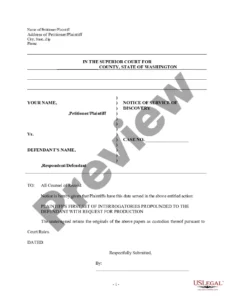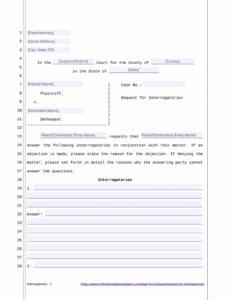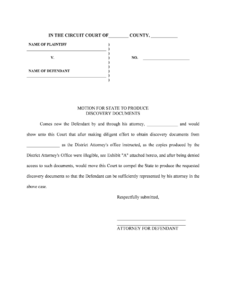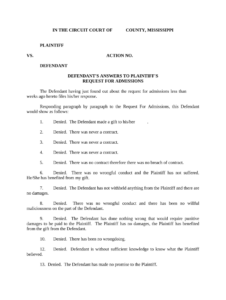Employing pre-designed formats for legal inquiries offers several advantages. Standardized phrasing reduces ambiguity and the likelihood of misinterpretation, promoting clarity and efficiency in the discovery process. This, in turn, can minimize disputes and expedite legal proceedings. Furthermore, using established templates ensures compliance with local court rules and procedures, reducing the risk of sanctions or delays. Finally, access to these resources can save valuable time and resources for legal professionals, allowing them to focus on case strategy and client representation.
This article will delve into the specific types of discovery requests available in Washington, exploring their appropriate uses and offering practical guidance on completing and serving these crucial legal documents. It will also address common challenges and offer best practices for navigating the discovery process effectively within the state’s legal framework.
Key Components of Washington State Discovery Request Forms
Effective discovery requests require specific elements to ensure clarity, enforceability, and compliance with Washington’s civil rules. The following components are typically crucial:
1: Case Caption: Accurate identification of the court, case number, and parties involved is essential for proper filing and processing.
2: Specific Requests: Clearly and concisely articulated requests for documents, interrogatories, or depositions are necessary. Ambiguity can lead to disputes and delays. Each request should be numbered for easy reference.
3: Legal Basis: Requests should be grounded in relevant legal rules and demonstrate a reasonable connection to the claims or defenses in the case. This justifies the request and protects against objections based on relevance or overbreadth.
4: Scope and Timeframe: Defining the scope of the request, including specific date ranges or subject matter limitations, helps prevent overly burdensome or irrelevant discovery. This promotes efficiency and proportionality.
5: Response Instructions: Clear instructions on how and when to respond, including the format for producing documents or answering interrogatories, are essential. This ensures compliance and avoids misunderstandings.
6: Signature and Certification: The requesting attorney’s signature and certification of compliance with applicable rules are required to validate the request and affirm its legitimacy.
7: Service Information: Documentation of proper service of the discovery request upon the opposing party is crucial for maintaining a clear record and enforcing compliance.
Adherence to these structural elements ensures that discovery requests are legally sound, efficiently processed, and contribute effectively to case preparation within the framework of Washington State legal procedures.
How to Create a Washington State Discovery Request
Creating effective discovery requests in Washington State requires careful attention to detail and adherence to specific rules and procedures. The following steps outline the process:
1: Select the Appropriate Form: Begin by choosing the correct form for the specific type of discovery sought. Washington State provides standardized forms for various discovery methods, including interrogatories, requests for production of documents, and requests for admissions. Selecting the appropriate form ensures compliance with state requirements.
2: Accurately Complete the Caption: Correctly identify the court, case number, and parties involved in the caption section. Accuracy in this section is crucial for proper filing and processing of the request.
3: Draft Precise and Specific Requests: Clearly articulate the specific information or materials sought. Ambiguity should be avoided to minimize disputes and ensure efficient responses. Each request should be numbered for easy reference and organization.
4: Establish Legal Basis and Relevance: Explain the legal basis for each request, demonstrating its relevance to the claims or defenses in the case. This justification helps prevent objections based on irrelevance or overbreadth.
5: Define the Scope and Timeframe: Specify the scope of the request by including relevant date ranges or subject matter limitations. This helps ensure proportionality and prevents overly burdensome requests.
6: Provide Clear Response Instructions: Include detailed instructions on how and when to respond, including the format for producing documents or answering questions. This clarity minimizes potential misunderstandings and promotes timely compliance.
7: Include Required Signatures and Certifications: Ensure the requesting attorney signs the document and includes the required certifications of compliance with applicable rules. This step validates the request and affirms its legitimacy.
8: Effect Proper Service: Serve the discovery request upon the opposing party in accordance with Washington’s rules of civil procedure. Proper service is essential for enforcing compliance and maintaining a clear record of the proceedings.
By following these steps, legal professionals can create well-crafted discovery requests that comply with Washington State requirements, facilitate efficient information exchange, and contribute to effective case preparation.
Careful attention to detail and adherence to Washington’s specific rules are essential for effective discovery. Utilizing available resources, including standardized forms and established procedures, can streamline the process and minimize potential disputes. Understanding the key components of a valid request, such as clear articulation of the request, establishment of legal basis, and precise instructions for response, contributes significantly to efficient and effective discovery. Proper service and adherence to deadlines are crucial for maintaining compliance and ensuring the smooth progression of legal proceedings.
Proficiency in navigating the discovery process within Washington State’s legal framework is crucial for successful litigation. Effective utilization of discovery tools allows for thorough case preparation and informed legal strategies. Staying abreast of current rules and procedures ensures compliance and promotes efficient resolution of legal matters, ultimately contributing to a just and timely outcome.



